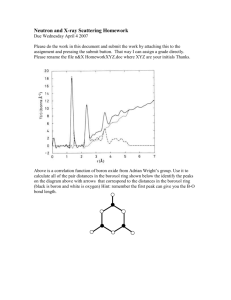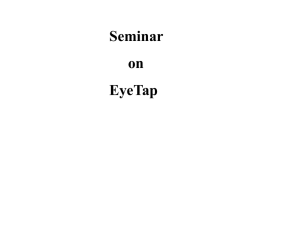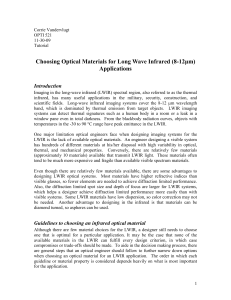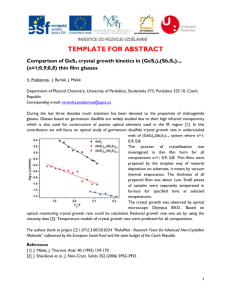Selecting Infrared Optical Materials
advertisement
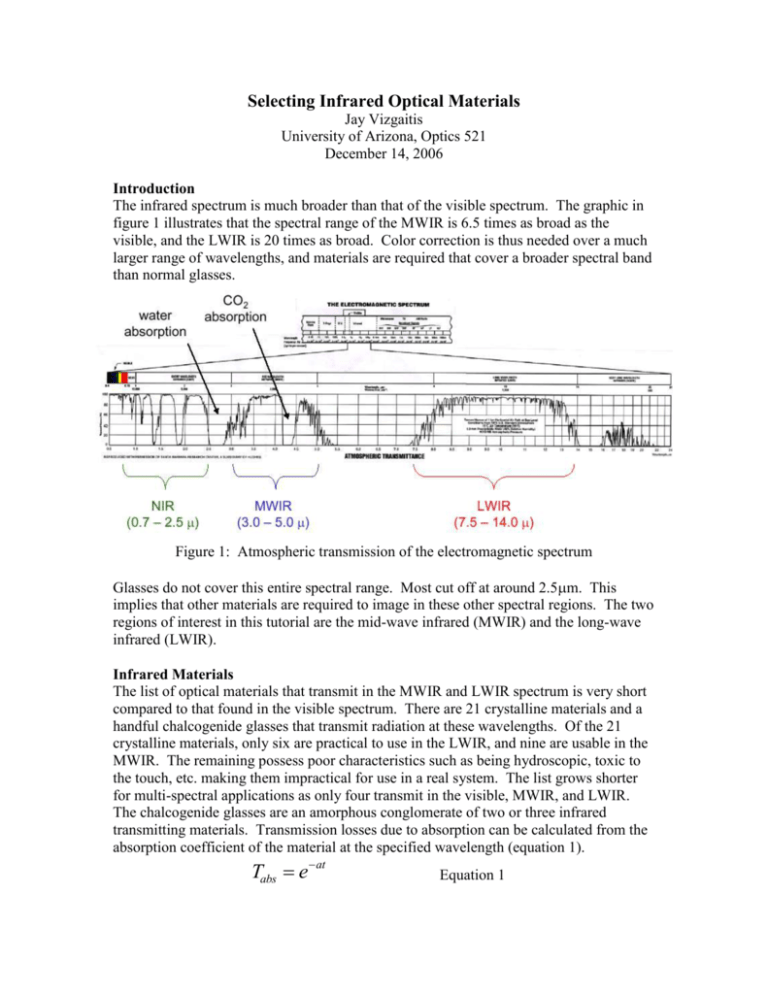
Selecting Infrared Optical Materials Jay Vizgaitis University of Arizona, Optics 521 December 14, 2006 Introduction The infrared spectrum is much broader than that of the visible spectrum. The graphic in figure 1 illustrates that the spectral range of the MWIR is 6.5 times as broad as the visible, and the LWIR is 20 times as broad. Color correction is thus needed over a much larger range of wavelengths, and materials are required that cover a broader spectral band than normal glasses. Figure 1: Atmospheric transmission of the electromagnetic spectrum Glasses do not cover this entire spectral range. Most cut off at around 2.5m. This implies that other materials are required to image in these other spectral regions. The two regions of interest in this tutorial are the mid-wave infrared (MWIR) and the long-wave infrared (LWIR). Infrared Materials The list of optical materials that transmit in the MWIR and LWIR spectrum is very short compared to that found in the visible spectrum. There are 21 crystalline materials and a handful chalcogenide glasses that transmit radiation at these wavelengths. Of the 21 crystalline materials, only six are practical to use in the LWIR, and nine are usable in the MWIR. The remaining possess poor characteristics such as being hydroscopic, toxic to the touch, etc. making them impractical for use in a real system. The list grows shorter for multi-spectral applications as only four transmit in the visible, MWIR, and LWIR. The chalcogenide glasses are an amorphous conglomerate of two or three infrared transmitting materials. Transmission losses due to absorption can be calculated from the absorption coefficient of the material at the specified wavelength (equation 1). Tabs e at Equation 1 A table of the practical infrared materials is listed along with a chart of their spectral bands (figure 2 and table 1). Transmission Range for Common IR Materials Sapphire MgO Silicon AsS3 CaF2 BaF2 GaAs AMTIR-1 AMTIR-3 AMTIR-4 GASIR1 GASIR2 Germanium ZnSe ZnS (Cleartran) 0.1 0.5 1.0 5.0 Wavelength (m) 10.0 50.0 Amorphous Glasses Crystalline Materials Figure 2: Transmission of usable infrared materials Table of Infrared Optical Materials Refractive Index =4m =10m dn/dT (K-1) Spectral Range Germanium 4.0243 4.0032 .000396 2.0 – 17.0 m Gallium Arsenide 3.3069 3.2778 .000148 0.9 – 16.0 m ZnSe 2.4331 2.4065 .000060 0.55 – 20.0 m ZnS (cleartran) 2.2523 2.2008 .000054 0.37 – 14.0 m AMTIR-1 2.5141 2.4976 .000072 0.7 – 14.0 m AMTIR-3 2.6200 2.6002 .000091 1.0 – 14.0 m AMTIR-4 2.6487 2.6353 -.000030 1.0 – 14.0 m GASIR1 2.5100 2.4944 .000055 1.0 – 14.0 m GASIR2 2.6038 2.5841 .000058 1.0 – 14.0 m Silicon 3.4255 N/A .000160 1.2 – 9.0 m Sapphire 1.6753 N/A .000013 0.17 – 5.5 m BaF2 1.4580 1.4014 -.000015 0.15 – 12.5 m CaF2 1.4097 1.3002 -.000011 0.13 – 10.0 m As2S3 2.4112 2.3816 -.0000086 0.65 – 8.0 m MgO 1.6679 N/A .000011 0.4 – 8.0 m Material Table 1: Indices and dn/dT of usable infrared materials Dispersion Dispersions for the different materials in the different spectral bands are shown in the glass maps in figure 3. Figure 3: Glass map for some infrared materials in the MWIR and LWIR1 The most interesting material to note on these maps is that of germanium. Germanium has a V-value of about 100 in the MWIR, but greater than 1200 in the LWIR. The amount of dispersion drastically increases in the MWIR from the LWIR. In fact, the Germanium dispersion is so good in the LWIR, entire optical system can be made with just the one material, and can be done so without the need of any other glasses to help color correct. Adding other materials will actually generally add to the dispersion. In the MWIR there are no materials like this, and thus color correction must be accomplished with matching different dispersions to different powers. The lack of materials can make this task difficult, along with the generally inability to fabricate cemented doublets in the infrared. Many designers end up using diffractives to solve the color correction problem, although, with careful glass selection, color correction is possible. A more daunting problem is the design of broadband optical systems that span both the MWIR and LWIR. With even fewer materials available, and dispersion values that change with wavelength, this task can be quite the challenge. Special Considerations In the LWIR, Germanium is by far the best material to use for color correction and simplicity of design due to its high index of refraction and low dispersion. It is possible to design entire systems with Germanium, but there are some caveats to this choice. Temperature plays havoc on Germanium in two ways. It has a very high dn/dT (0.000396 K-1), defocusing a lens that changes temperature of only a few degrees. It also has an absorption property in the LWIR for temperatures greater than 57C. As the optic temperature rises above this point, the absorption coefficent increases, reducing the transmission. This change in transmission can be calculated from equation 1. The high cost of Germanium can also be a factor. It is not always good choice for a low cost sensor, as the lens may end up costing more than the FPA. A good thermal match to compensate for the dn/dT of Germanium is AMTIR-4. Its negative dn/dT provides for an excellent compensator for the Germanium. It is possible to design a two lens Germanium/AMTIR-4 lens system that does not require refocusing for over a 60C temperature range. Figure 4: absorption coefficient vs. temperature vs. resistivity for Germanium at 11.9m2 The low cost optics are silicon, ZnS, and the chalcogenide glasses. Silicon is only usable in the MWIR, and although the material is very inexpensive, its hardness can make it very difficult to diamond turn, and thus expensive. Although it doesn’t diamond turn well, it does grind and polish easily, providing a very inexpensive solution when complex surfaces such as aspheres and diffractives are not used. ZnS is relatively inexpensive to Germanium and ZnSe, but is relatively expensive to silicon and the chalcogenide glasses. The chalcogenide glasses are by far the least expensive to make and manufacture making them an excellent solution for low cost system design. There are three types of the chalcogenide glasses that are moldable. AMTIR-4, a product of Amorphous Materials, Inc., has a lower melting point that the other chalcogenides making it the easiest to mold. Umicore produces GASIR1 and GASIR2 which have also been demonstrated as being moldable. They have similar optical properties to that of AMTIR-1 and AMTIR-3. 18:14:39 Reflective Optics Reflective optics can also be a very useful and effective design tool in the infrared. Reflective optics have no chromatic aberrations, and allow for diffraction limited solutions for very wide spectral bands. However, the use of reflective optics is somewhat limited to narrow fields of view. Fast f/number reflective designs are also very difficult to achieve. In addition, the type of reflective system can impact the performance fairly significantly for longer wavelengths. The most common type of design is the Cassegrain, which has two mirrors that are aligned on the same optical axis. The secondary mirror acts as an obscuration to the primary, which results in a degraded MTF due to diffraction around the obscuration. This effect is not apparent in most wavebands because the MTF loss occurs after the Nyquist frequency of the detector. However, this is not the case for the LWIR where the MTF drop occurs before Nyquist. This effect is demonstrated in figure 5. 16:03:15 perfect lens DIFFRACTION LIMIT DIFFRACTION MTF AXIS WAVELENGTH WEIGHT 9000.0 NM 1 28-Nov-00 DEFOCUSING 0.00000 1.0 0.9 0.8 0.7 M O 0.6 D U L 0.5 A T I O 0.4 N 0.3 0.2 0.1 1.0 6.0 11.0 16.0 21.0 26.0 31.0 36.0 41.0 46.0 51.0 SPATIAL FREQUENCY (CYCLES/MM) Figure 5: MTF impact of obscuration in LWIR Cassegrain objective This obscuration also creates problems in controlling stray light. To overcome these problems, most reflective systems used in the LWIR are off-axis reflective optics. These optics can provide diffraction limited MTF as long as the f/numbers do not get too fast, and the fields of view do not get too large. The off-axis nature makes these reflective systems hard to align, and often expensive to manufacture. So what do I choose? Not exactly an easy question. Everything depends on your applications and needs. The best answer is to take a look at priorities and performance requirements. Not every system is going to need diffraction limited optics. If cost is the number one priority, then try designing with the chalcogenide glasses and use ZnS or Silicon as to help balance the color. If performance is everything, Germanium is a very useful tool, but you need to be able to balance out its pitfalls. If there are just a few lenses, then temperature effects won’t be significant. A combination of both reflective and refractive components is often a good solution as well. Conclusion Designing optics in the infrared is both easier and harder at the same time. Proper choice of materials is very important, and knowing how your materials behave is the key. Creating a smaller subset of materials based on the requirements of your design is absolutely necessary prior to starting designs. References 1. Richard C. Juergens, “Infrared Optic Seminar”, University of Arizona, 2006. 2. J.C. Richter, C.R. Poznich, D.W. Thomas, “Minimization of IR absorption of IR Absorption by Germanium at Elevated Temperatures”, Window and Dome Technologies and Materials II, Proceedings SPIE 1326, p. 106-119, 1990.
